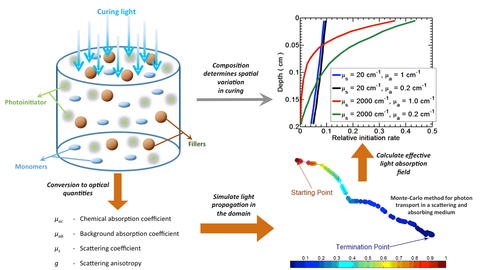Summary
Control over spatial uniformity in a photopolymerized material is important for homogenous physical properties. Unintended spatial variations in polymeric networks, particularly from reduced degree of polymerization conversion associated with reduced irradiation, may lead to premature material failure. As such, the distribution of light intensity to a photopolymerizing material is of importance, especially in filled composites with reduced irradiation from light scattering and absorption.
Description
In this work, we establish a method to calculate the spatial absorption and scattering parameters for composite resins during photopolymerization. The inputs to this model are based on the characteristics of the resin system (e.g., monomer and filler structure and composition, filler size and density, initiator absorption spectrum) and spectral irradiance of the light source. From this model, we can assess the sensitivity of the optical properties (scattering and absorption) with respect to changes in composition.
The optical properties can then be used to understand the irradiation density due to photon transport during photopolymerization. This approach is useful to quantify differences in the extent of polymerization due to varying light irradiance within a bulk polymerizing material, including materials of complex shapes. The variation in curing light intensity is related to the physical properties of photocured materials.


